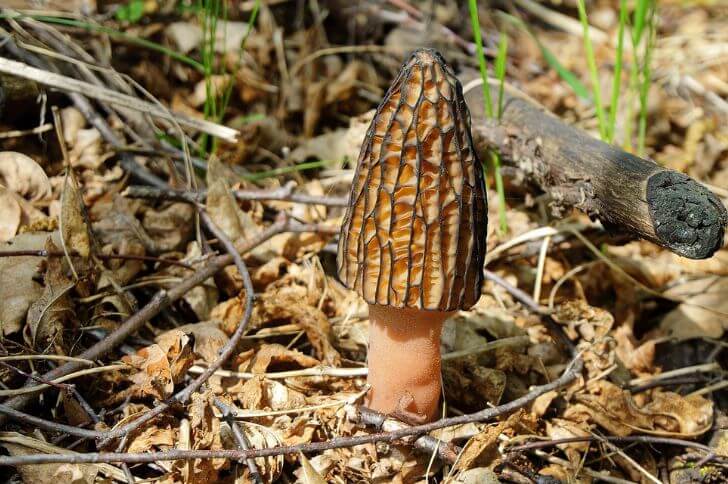Mushrooms can be found growing in the wild or cultivated in farms. They come in various colors. One of these striking colors is yellow. Yellow mushrooms can be found in various locations all over North America and the world. Also, some are edible, while others are not.
Some common yellow mushrooms include the Leucocoprinus birnbaumii or the plantpot dapperling commonly found in potted plants, golden oyster and chicken of the woods. Below we’ll look at how to identify these mushroom species and others that fall within this category.
List of Edible Yellow Mushrooms
Don’t eat mushrooms or fungi that have not been classified and identified as edible. Also make sure to cook all edible fungi before consumption.
1. Butter-foot Bolete

Butter-foot bolete mushrooms are yellow fungi that typically grow in hardwood forests, mostly around beech and oak trees. Scientifically called Boletus auripes, this spored mushroom is common in some states; Florida, Eastern Texas, and North Carolina.
Identification:
Butter-foot boletes are very distinctive. First, they are yellow. Unlike most boletes, they do not change color as they age. The convex shaped cap grows to 5.1 inches, making them one of the largest yellow mushrooms. Also, the 1.2-inch thick stem grows to about 3.9 inches.
Second, you can identify them by their pores. Instead of gills, this large mushroom has yellow-brown spores.
Boletus auripes mushrooms are relatively easy to find in the wild, especially in North America. However, they can also be cultivated. When harvesting these mushrooms, it is important to be careful not to damage the delicate spongy flesh.
Best way to use these yellow fungi? I recommend you dry and use them in sauces. Best way to get their flavor.
2. Scaly Pholiota

Going mushroom hunting in Colorado? The shaggy scalycap or scaly Pholiota is a parasitic mushroom that occurs all over North America and parts of Europe.
Identification:
This yellow fungi grows in tight clusters on conifer trees or on decaying wood. The caps of these mushrooms are scaly or hairy, and the adnate gills turn from yellow to brownish as the muhroom matures. Stalk is also scaly.
Is the Scaly pholiota edible? Yes. Some people have described its lemon-garlic smell as off-putting and has a bitter taste. Also they must be cooked before eating. But my honest opinion is, go for other better-tasting yellow mushrooms like the chicken of the woods. These mushrooms can be found in woods and fields from late summer to early fall.
3. Golden Chanterelle
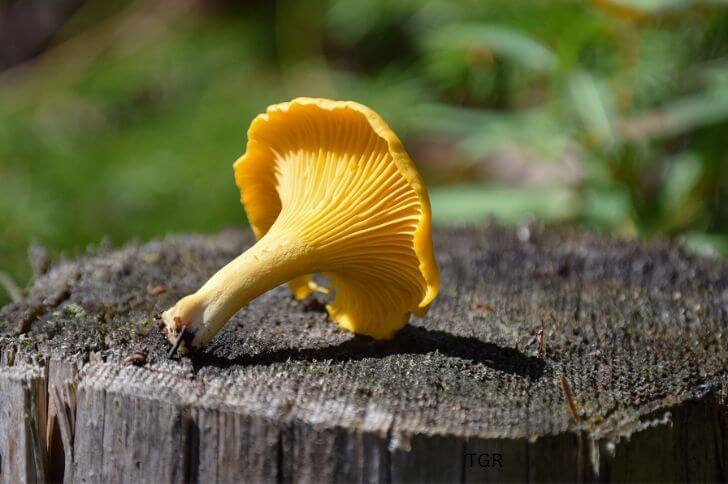
Golden chanterelle mushrooms are bright yellow fungi that occur in various parts of Europe and North America. Like other members of the cantharellaceae family, they are highly sought after because of their unique fruity aroma when cooked.
Identification:
They have distinctively funnel-shaped caps with ridges running down the center. The flesh of the mushroom is yellow or bright orange in color. Golden chanterelles are considered to be a delicacy by many people and are often used in high-end cuisine.
These mushrooms can be difficult to find, as they only grow in certain areas. However, they can sometimes be found in grocery stores or online retailers that specialize in selling mushrooms. If you’re lucky enough to find some golden chanterelles, be sure to clean them properly. I recommend you pick young golden chanterelles.
4. Chicken of the woods
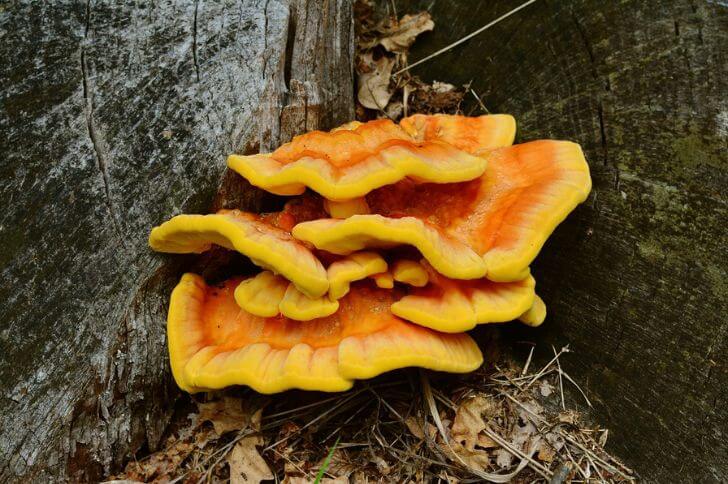
Chicken of the woods or chicken fungus or sulfur shelf or Laetiporus is a polypore mushroom that grows on trees, and is often considered a delicacy. These mushrooms occur all over North America and the color ranges from yellow to orange, depending on the host tree.
Identification:
The mushroom is characterized by its yellow to orange color, and its meaty texture. It can be found growing on eucalyptus and conifer trees. Unlike other yellow mushrooms on this list, they do not have stems. The cap ranges from 2-10 inches.
Sulphur shelf mushroom caps are wrinkled and have yellowish spore print underneath. When can you find chicken of the woods? August-November. We recommend you harvest young and tender fungi.
When preparing chicken of the woods for cooking, it is important to remove any dirt or debris. The mushroom can then be cut into thin slices or diced. These yellow mushrooms can be cooked in a variety of ways, including sautéing, grilling, or baking.
Chicken of the woods is a nutritious food source that is high in protein and low in fat. Additionally, it contains vitamins and minerals such as potassium and magnesium.
5. Ochre Brittlegill

The Ochre brittlegill is a large, delicate mushroom that grows in woodlands in the spring and summer.
Identification:
The caps of these mushrooms are a pale yellow, and the gills are creamy white. Note, gills turn darker as the brittlegill ages. These mushrooms are often found growing under aspen and birch.
The yellow brittlegill is not only beautiful but also edible. This mushroom can be used in soups, stews, or sautéed and served as a side dish. When cooking with this gilled mushroom, it is important to remember that it is delicate and should be handled with care.
6. Yellow Pholiota
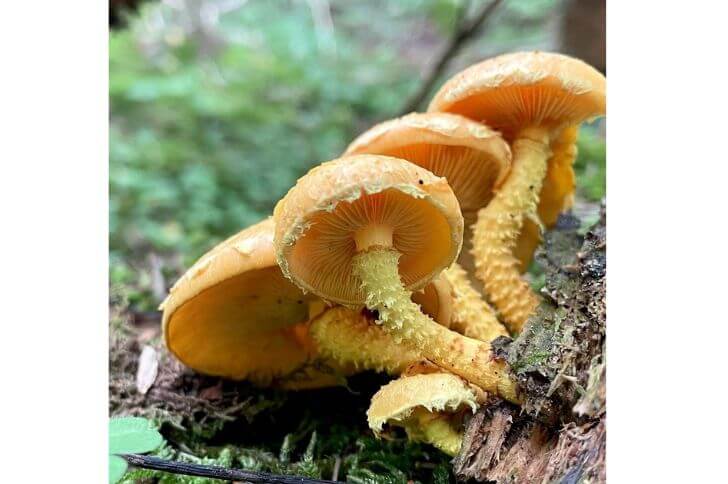
Another member of the pholiota genus that has yellow color on its fruiting body is the yellow pholiota.
Identification:
Other names for the yellow pholiota are the flame scalecap or flaming Pholiota. They are identifiable by their yellow fruiting bodies and broad convex caps.
Like the other pholiota species above, they have hairy scales and are slimy. Note the flesh is yellow. Is the yellow pholiota edible? This yellow capped mushroom is not yet classified. So, it’s best to avoid it.
7. Golden Oyster Mushrooms
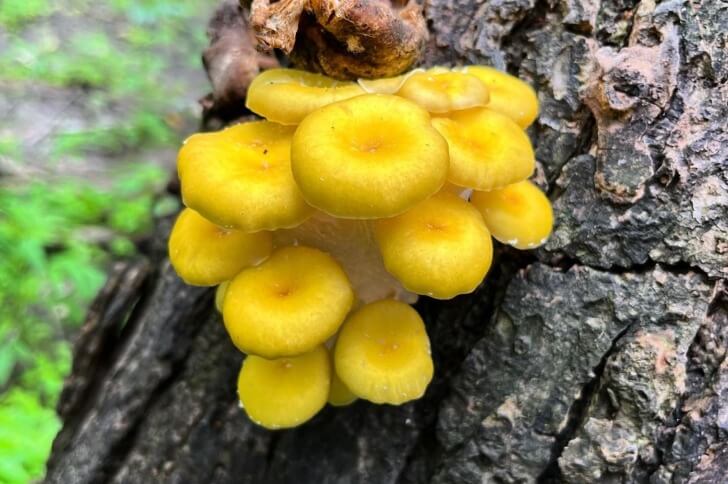
Beautiful and fragile, the golden oyster mushroom is a new species in the pleurotaceae family. They are native to parts of the midwest.
Identification:
Golden oyster mushrooms have yellow-brown velvety 0.5-2.5 inch caps with closely spaced white gills. Like other oysters, their bodies resemble funnels with white spore print. They grow in clusters.
Are golden oysters invasive? In my opinion they are. And most mushroom hunters have noted that with the spread of golden oysters, there is a great impact on native mushrooms such as morels which grow on dead elms.
When harvesting this yellow mushroom species, check if there are any bug holes and go for the largest and youngest cluster. For this yellow fungi, I recommend the oyster mushroom steak recipe.
8. Golden Ear

Golden ear mushrooms are bright yellow fungi that are widespread in North America. They are parasitic, preferring dead broadleaf trees.
Identification:
This jelly fungus has a lobed cap that grows to about 6 inches across during the wet season. When it dries up, the cap shrivels up and has an orangish color. They have white spores. Golden ear fungi are edible but have no culinary value.
9. Golden Coincap
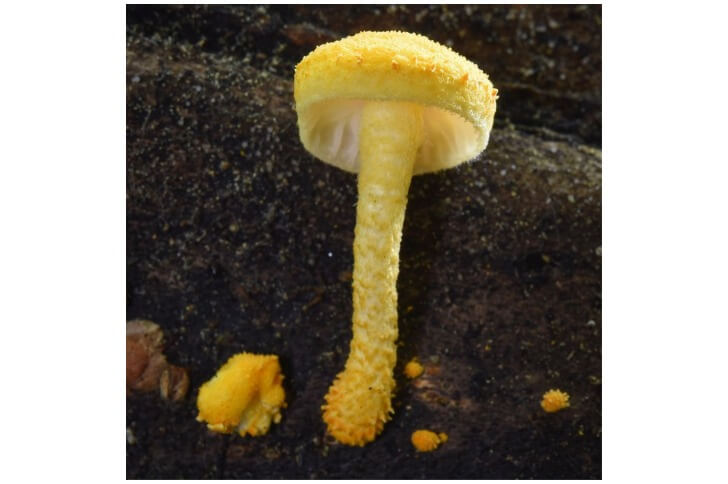
Golden coincap or the Cryptotrama chrysopepla is a little yellow mushroom that is known for its beauty. They favor warm and moist conditions.
Identification:
These small yellow mushrooms have convex caps that eventually become flat. Caps are scaly on their margins and have broadly attached gills. Tall stalk attaches itself to a tree and is about 1.6 inches tall. They have yellowish flesh. Edibility is unknown
10. Mud puppy

Native to California, mud puppy or Cantharellus californicus or oak chanterelle are members of the popular edible chanterelle family.
Identification:
It is similar in appearance to most yellow mushrooms of the chanterelle family. Its funnel-shaped body is egg yellow, measuring 2-12 inches wide and can weigh up to 4.4 lb. They are some of the largest yellow chanterelles. Inner flesh is yellowish.
What do oak chanterelles taste like? The flavor of these California mushrooms is fruity and I like that they don’t lose much flavor even after cooking. Plus, their size is awesome.
11. Wood Hedgehog
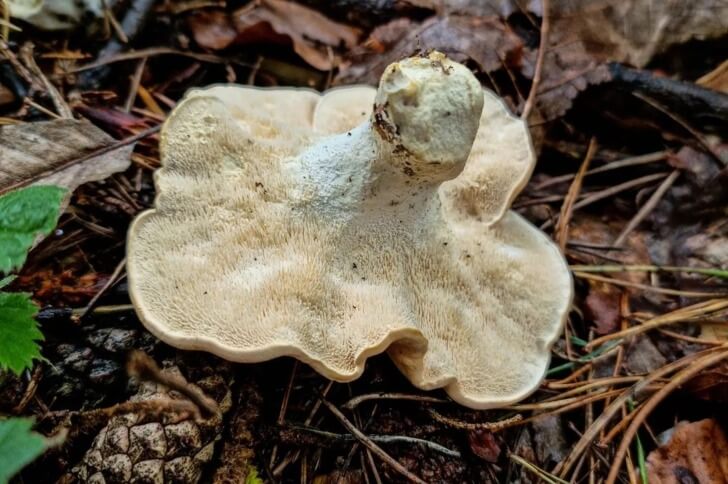
From Europe to North America, the wood hedgehog is a common unmistakable mushroom. It has other names including hedgehog mushroom or sweet tooth. Scientific name Hydnum repandum.
Identification:
How can you identify this yellow mushroom when scouring the woods? Check for orange-yellow mushrooms that range from 2-6 inches in diameter depending on the age. And unlike gilled mushrooms, hedgehog mushrooms have tiny spines under the cap that gives them their name. When mature, they resemble the yellow chanterelles above.
While they may look dangerous, wood hedgehogs are actually edible. They can be found fresh or dried in many grocery stores. When cooked, they have an earthier flavor that goes well with meats and other savory dishes.
Inedible Yellow Mushrooms
12. Flowerpot parasol (Leucocoprinus birnbaumii)
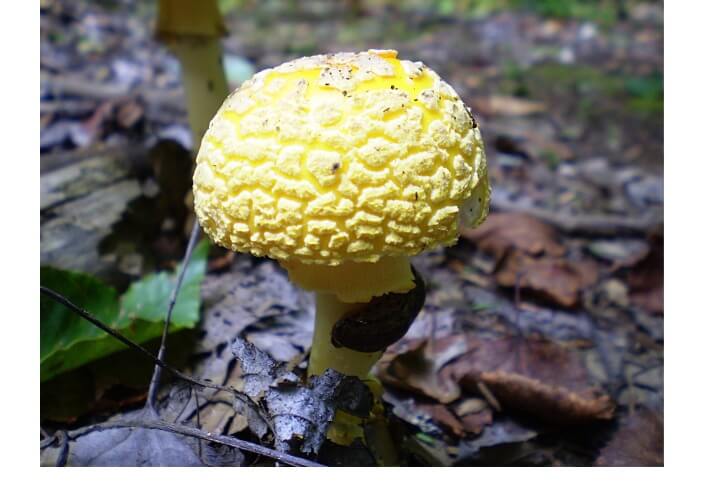
Seen a yellow mushroom in houseplant? The plantpot dapperling or flowerpot parasol or Leucocoprinus birnbaumii is a common mushroom that grows on a potted plant.
Identification:
This small yellow mushroom prefers potting soil with dead organic matter. The Leucocoprinus birnbaumii typically grows on the roots of plants. The fruit body of the fungus is a small, white to yellow mushroom with a broadly convex 1-2 inch cap.
Undercap you’ll note crowded pale yellow gills. The spores are white and spherical while the stalk is about 2 inches tall and smooth.
They can appear indoors at any time of the year and outdoors during warmer months. If you suspect you have a yellow houseplant mushroom, it is best to remove it from your home and dispose of it properly.
Leucocoprinus birnbaumii is considered a pest in greenhouses and gardens, as it can quickly consume organic matter.
13. Yellow Webcap Mushrooms
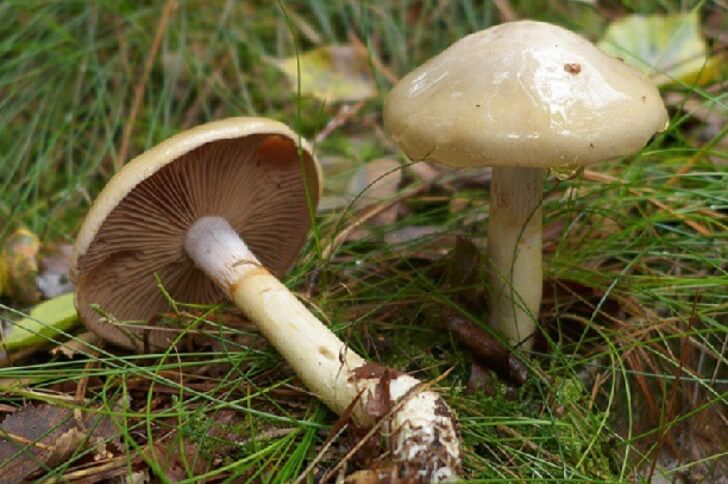
Commonly found around birch trees, the yellow webcap mushrooms are small yellow mushrooms that occur in Northern America.
Identification:
The 1.6-3.6 inch caps of these mushrooms are pale yellow in color and have a convex shape that flattens as it matures. The gills of these mushrooms are bluish, giving them their name bluegill webcap. They are not attached to the stem. Its flesh is also yellowish and soft. These little yellow mushrooms are inedible.
14. Jack-o-Lantern
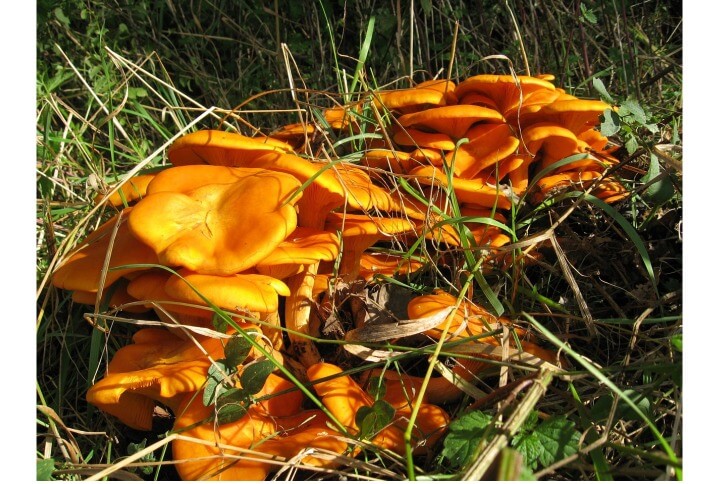
When hunting, I recommend you be very careful. Why? because of species like Jack-o-lantern. Scientific name Omphalotus olearius, jack-o-lantern are deceitful yellow mushrooms that look like some popular mushrooms like chanterelles and chicken of the woods.
Identification:
They grow in wooded areas and wood edges, and can grow on decaying logs or stumps. The cap of this wild mushroom is usually between 2-4.5 inches wide, and the stems are pale orange. Mushroom spores are pale yellow.
15. Peeling Oysterling
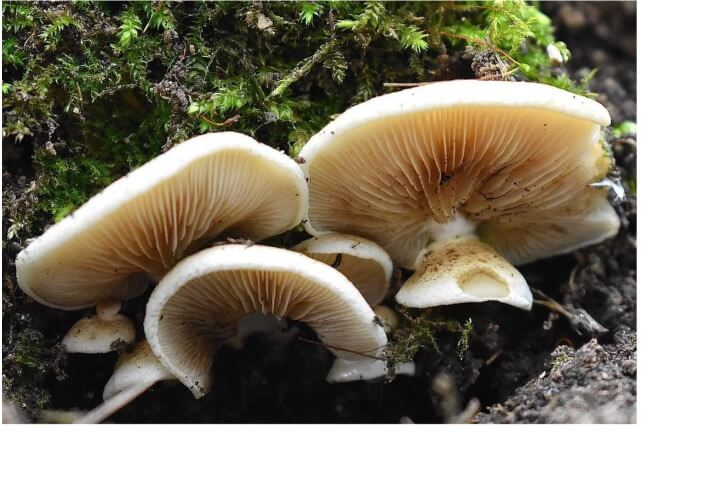
Crepidotus mollis or soft slipper or jelly crep or the peeling oysterling is a species of the genus crepidotus. The name is derived from the Greek word for slipper, krepis, referring to the shape of the fruiting body.
Identification:
The fruiting body of a peeling oysterling fungus typically consists of a kidney-shaped cap without a stalk. The gills on the underside of the cap are brownish and produce spores that are dispersed by wind or water. Peeling oysterling is inedible.
16. Yellow American Blusher
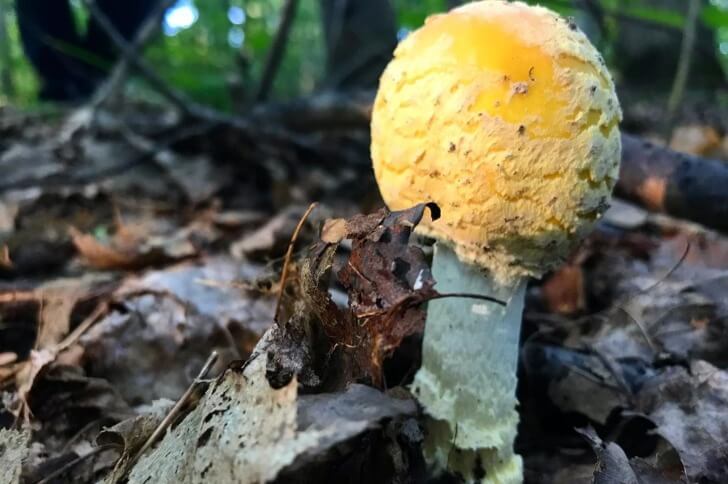
First found in Ohio, the yellow American Blusher or Yellow American blusher Amanita is a large mushroom of the Amanita family.
Identification:
They are commonly associated with birches, oaks and pines. The 1.8-5.5 inches wide broadly convex cap is yellow-brown or bright yellow in color. Cap also has warts like other red colored mushrooms of their family.
The underside has crowded gills that are slightly attached to the pale yellow stem. Note the thick base of the stipe. Can you eat yellow American blushers? They have not yet been classified. But like other plants in their family, we recommend you do not eat this species.
FAQs
What yellow mushrooms are edible?
Some edible yellow capped fungi are yellow chanterelles, hedgehog mushrooms, chicken of the wood and butter-foot boletes.
What are small bright yellow mushrooms?
Flowerpot parasol or Leucocoprinus birnbaumii are small yellow mushrooms that are commonly found in house plants and can invade the yard depending on the season.
Sources:
Hi There,
My name is Jenny. I’m the Chief Editor at Try Green Recipes and besides making yummy and healthy foods for my kids, grandkids, and friends. I’m new to the blogging world but I believe what I have to share is unique and will bring joy to your home. If you are adventurous and want try something tasty, let’s get started.

